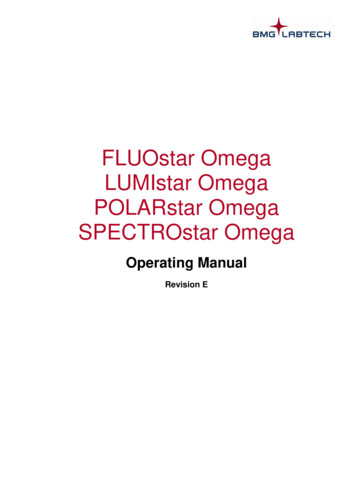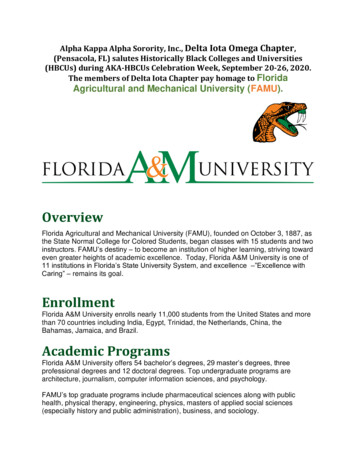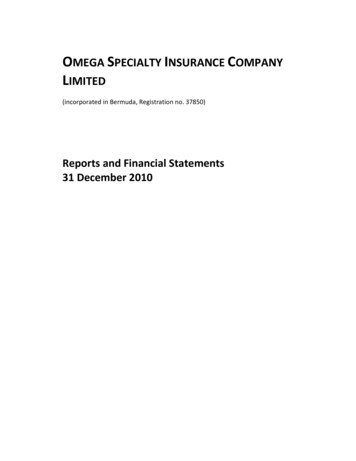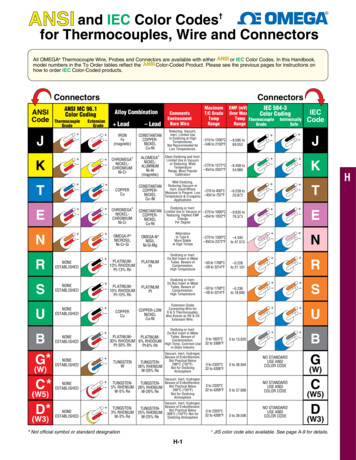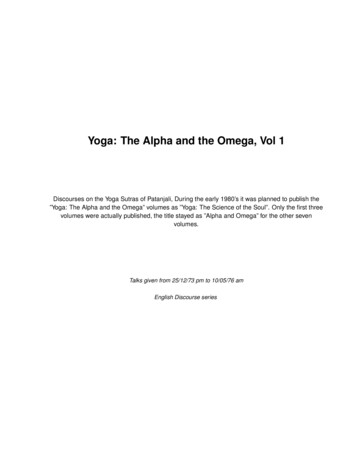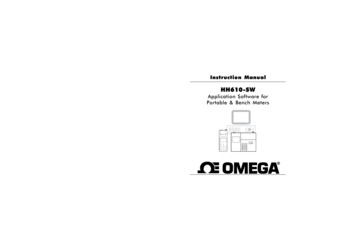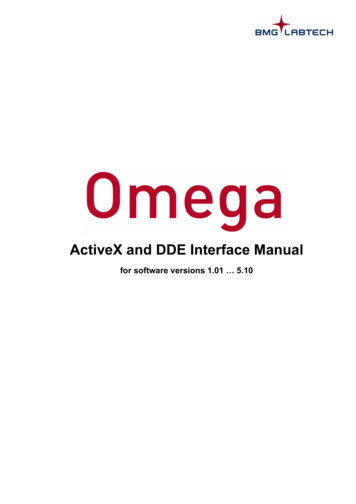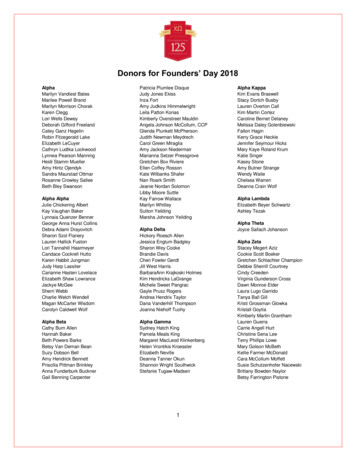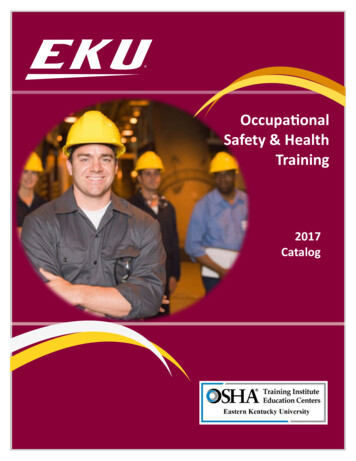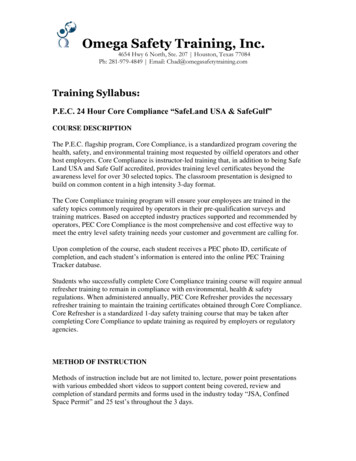
Transcription
Omega Safety Training, Inc.4654 Hwy 6 North, Ste. 207 Houston, Texas 77084Ph: 281-979-4849 Email: Chad@omegasafetytraining.comTraining Syllabus:P.E.C. 24 Hour Core Compliance “SafeLand USA & SafeGulf”COURSE DESCRIPTIONThe P.E.C. flagship program, Core Compliance, is a standardized program covering thehealth, safety, and environmental training most requested by oilfield operators and otherhost employers. Core Compliance is instructor-led training that, in addition to being SafeLand USA and Safe Gulf accredited, provides training level certificates beyond theawareness level for over 30 selected topics. The classroom presentation is designed tobuild on common content in a high intensity 3-day format.The Core Compliance training program will ensure your employees are trained in thesafety topics commonly required by operators in their pre-qualification surveys andtraining matrices. Based on accepted industry practices supported and recommended byoperators, PEC Core Compliance is the most comprehensive and cost effective way tomeet the entry level safety training needs your customer and government are calling for.Upon completion of the course, each student receives a PEC photo ID, certificate ofcompletion, and each student’s information is entered into the online PEC TrainingTracker database.Students who successfully complete Core Compliance training course will require annualrefresher training to remain in compliance with environmental, health & safetyregulations. When administered annually, PEC Core Refresher provides the necessaryrefresher training to maintain the training certificates obtained through Core Compliance.Core Refresher is a standardized 1-day safety training course that may be taken aftercompleting Core Compliance to update training as required by employers or regulatoryagencies.METHOD OF INSTRUCTIONMethods of instruction include but are not limited to, lecture, power point presentationswith various embedded short videos to support content being covered, review andcompletion of standard permits and forms used in the industry today “JSA, ConfinedSpace Permit” and 25 test’s throughout the 3 days.
COURSE OBJECTIVESBuild safety awareness and proactive behaviors in employees to improve safety andhealth performance on and off the job. Provide awareness level knowledge and skillrequired to identify, analyze, and apply control strategies to eliminate or reduce exposureto occupational health and safety hazards, hazardous conditions and unsafe practices onthe jobsite.COURSE TOPICS/UNITS AND DATESDay 1: 8 Hours1.) General Safety Chapter Introduction Behavioral Based Safety (BBS) Communication Short Service Employee Office Safety Housekeeping/Sanitation Drug-Free Workplace Program Motor Vehicle Safety Chapter Conclusion Stop and Think2.) Safe Work Planning and Practices Chapter Introduction Identifying Hazards Analyzing Hazards Controlling Hazards Chapter Conclusion Stop and Think3.) Emergency Preparedness and Response Chapter Introduction Potential Emergencies Emergency Action Plans OSHA Minimum Requirements Alarm Systems Training Chapter Conclusion Stop and Think
4.) Work Place Violence Chapter Introduction Aggressive Behavior Reporting and Discipline Cyber Security Maritime Security Terrorism Response Awareness Program (TRAP) Chapter Conclusion Stop and Think5.) First Aid and Medical Chapter Introduction Recordkeeping Basic First Aid Tuberculosis (TB) Accident Reporting Chapter Conclusion Stop and Think6.) Hazard Communication w/GHS Chapter Introduction The Globally Harmonized System Right to Know Right to Understand Hazard Classification Activity-Health Hazards Hazard Communication Standard Product Warning Labels Safety Data Sheets Written Hazard Communication Standard Program Training Chapter Conclusion Stop and Think Assessment
7.) Personal Protective Equipment Chapter Introduction Requirements for Personal Protective Equipment Hazard Assessment Selecting PPE Training Eye and Face Protection Head Protection Foot and Leg Protection Hand and Arm Protection Body Protection Hearing Protection Respiratory Protection Chapter Conclusion Stop and ThinkDay 2: 8 Hours1.) Occupational Noise Exposure Chapter Introduction Effects of Noise Hearing Conservation Standard Hearing Conservation Program Controls Hearing Protection Training Audiometric Testing Chapter Conclusion Stop and Think2.) Respiratory Protection Chapter Introduction Respiratory Protection Program Medical Evaluation Immediately Dangerous to Life and Health (IDLH) Types of Respirators Respiratory Protection Training Chapter Conclusion Stop and Think
3.) Occupational Health Hazards Chapter Introduction Industrial Hygiene Air Contaminants Chemical Hazards Biological Hazards Physical Hazards Ergonomics and Back Safety Chapter Conclusion Stop and Think4.) Hydrogen Sulfide Chapter Introduction Properties and Characteristics Sources Exposure Controls Detecting and Monitoring Contingency Plan Rescue Chapter Conclusion Stop and Think5.) Fire Safety Chapter Introduction Fire Theory Workplace Fire Hazards Fire Prevention Fire Protection Fire Detection Fire Extinguishing Incipient Firefighting Fire Brigades Burns and First Aid Chapter Conclusion Stop and Think
6.) Work Permits and Permit Required Confined Space Chapter Introduction Work Permits Confined Spaces Confined Space Hazards Testing for Hazardous Atmospheres Permit Required Confined Space Program Entry Permit Emergency and Rescue Training Chapter Conclusion Stop and Think7.) Control of Hazardous Energy / Lockout / Tagout Chapter Introduction Hazardous Energy Written Program Workers Involved LOTO Application Equipment Types of Energy Applying Controls LOTO Removal Restoring Energy Additional Requirements Chapter Conclusion Stop and Think8.) Welding Safety Chapter Introduction General Safety PPE First Aid and Hygiene Transporting, Moving, and Storing Compressed Gas Cylinders Cylinder Placement and Use Welding Equipment Safety Fire Prevention Chapter Conclusion Stop and Think
9.) Electrical Safety Chapter Introduction Electrical Safety Unsafe Work Practices Energized vs De-Energized Overhead Line Safety Preventing Accidents and Injuries Other Electrical Hazards Assured Grounding Program PPE Training Chapter Conclusion Stop and ThinkDay 3: 8 Hours1.) Fall Protection Chapter Introduction When Fall Protection is Necessary Nature of Fall Hazards Selection and Use of Fall Arrest System Rescue Plan Other Fall Protection Controlled Access Zones Safety Monitoring Systems Warning Line Systems Erection and Overhead Protection Training Chapter Conclusion Stop and Think2.) Walking Working Surfaces and Elevated Work Chapter Introduction Elevated Work Slips, Trips, and Falls Ladders Stairways and Handrails Scaffolds Fall and Falling Object Protection Guarding Floor Openings, Wall Openings and Holes Housekeeping Training Chapter Conclusion Stop and Think
3.) Excavation and Trenching Chapter Introduction Excavation Hazards Cave-in Prevention Soil Types Angles of Repose Additional Precautions Emergency Plan Chapter Conclusion Stop and Think4.) Machinery, Handheld Equipment and Power Tools Chapter Introduction Machine Safety Mechanical Power Press Forging Machines Hand Safety and Hand Tools Woodworking Tools Chapter Conclusion Stop and Think5.) Materials Handling Chapter Introduction Materials Handling Powered Industrial Trucks/Forklifts Aerial Lifts Types of Cranes/ Hoisting Mechanisms Rigging Safety Types of Slings Sling Inspection Communication Taglines Weight and Center of Gravity Chapter Conclusion Stop and Think
6.) Hazardous Waste Operations and Emergency Response Chapter Introduction Training Requirements Observation Recognition Identification of Hazardous Substances Site Control Hazard and Risk Assessment PPE Decontamination Basic Control and Containment Techniques Terminating the Incident Chapter Conclusion Stop and Think7.) Process Safety Requirements Chapter Introduction Program Elements Process Safety Management Safety and Environmental Management Systems Chapter Conclusion Stop and Think8.) Offshore Orientation Chapter Introduction Preparing to Go Offshore Non-permissible Items Shore base Environmental Regulations Helicopter Transportation Boat Transportation Transferring to the Offshore Facility Arrival at the Offshore Facility Water Safety Chapter Conclusion Stop and ThinkTEXTBOOK(S) AND REQUIRED TOOLS OR SUPPLIES1. P.E.C Core Compliance Textbook supplied for each student2. Student Test Answer Sheet supplied for each student3. Pen’s, Hand-out’s and form provided for each student
TESTING & GRADING PLAN1. Grading and testing procedures will strictly follow P.E.C. Policy andProcedure requirements.2. Each Test has 4 different versions “Test A, B, C, & D” Students sittingnext to each other will have a different version of the test.3. Each Student must pass each of the 25 tests with a passing grade of 80%or better. Should a student fail a test, by PEC policy that student is allowedto be retested only once per test with a different version of the test. Shoulda student fail the second time, that student will be excused from the classand will be required to start the class over.4. All retests will be conducted at the end of each day allowing the student(s)that did not fail a chance to leave on time and not be held up. This willallow for more one-on-one time with the student(s) that failed to identifyany areas of concern and answer any questions they may have.5. Any student caught cheating during any tests will be immediately removedfrom the class and our specified contact will be notified immediately.Cost:Contact us for more details.
P.E.C. 24 Hour Core Compliance “SafeLand USA & SafeGulf” COURSE DESCRIPTION The P.E.C. flagship program, Core Compliance, is a standardized program covering the health, safety, and environmental training most requested by oilfield operators and other host employers. Core Compliance i
